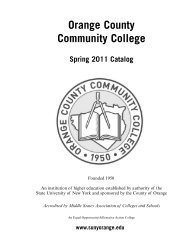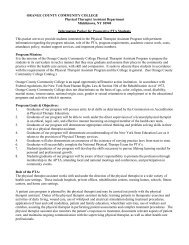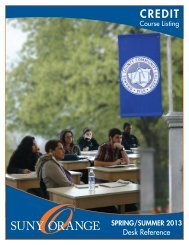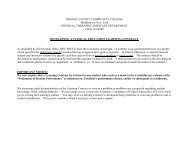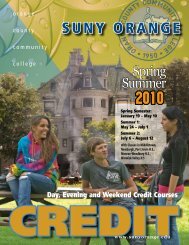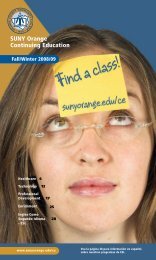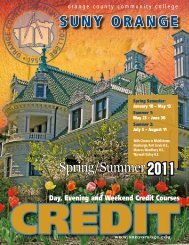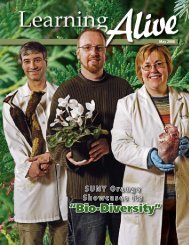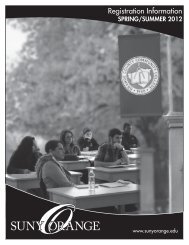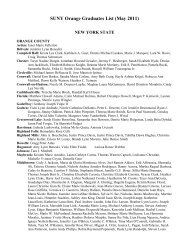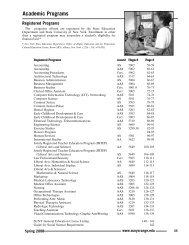You also want an ePaper? Increase the reach of your titles
YUMPU automatically turns print PDFs into web optimized ePapers that Google loves.
Chemistry<br />
Chemistry<br />
(Science, Engineering & Architecture Dept.)<br />
(see also: Physical Science, Physics)<br />
CHM 103—Applied Chemistry 1<br />
2 lect., 3 lab., 3 cr. (Fall)<br />
A study of the fundamental concepts of inorganic<br />
chemistry and techniques to be used in clinical<br />
laboratories. Topics include the nature of matter, the<br />
mole concept nomenclature, redox reactions, solutions,<br />
chemical equilibrium, acids and bases, and the gas laws.<br />
Laboratory work stresses skills and techniques useful to<br />
the laboratory technician. This course is closed to<br />
students who have completed or are currently enrolled<br />
in CHM 105, 106, 201 or 202. (GE 2)<br />
Corequisite: MAT 101 or Math Placement test into<br />
MAT 102 or higher<br />
CHM 104—Applied Chemistry 2<br />
2 lect., 3 lab., 3 cr. (Spring)<br />
Continuation of CHM 103. Topics include acid base<br />
chemistry, nuclear chemistry, organic chemistry with an<br />
emphasis on nomenclature, simple chemical reactions,<br />
boiling points/ solubility in water, and organic<br />
functional families. Laboratory work emphasizes<br />
quantitative techniques. The use of periodicals is<br />
required. (GE 2)<br />
Prerequisite: CHM 103 or permission of department<br />
chair<br />
CHM 105—General Chemistry 1<br />
3 lect., 3 lab., 4 cr.<br />
(Fall/Spring/Summer I)<br />
A study of the fundamental principles of chemistry.<br />
Topics include: stoichiometry, gases, atomic structure,<br />
periodic properties, ionic and covalent bonding, Lewis<br />
structures, liquids and solids. Laboratory work is the<br />
application of these principles with emphasis on<br />
quantitative relationships. The keeping of a<br />
laboratory notebook is required. (GE 2)<br />
Prerequisite: MAT 102 or Math Placement test into<br />
MAT 121<br />
CHM 106—General Chemistry 2<br />
3 lect., 3 labs., 4 cr. (Fall/Spring/Summer II)<br />
Topics include: Chemical equilibrium, acid-base<br />
theories, solubility equilibria, thermochemistry,<br />
thermodynamics, chemical kinetics, nuclear reactions,<br />
electrochemistry, an introduction to organic<br />
chemistry and some representative biomolecules.<br />
Laboratory work includes the above topics, plus<br />
qualitative analysis of select cations, and<br />
chromatography. The keeping of a laboratory<br />
notebook and the writing of formal reports is<br />
emphasized. (GE 2)<br />
Prerequisite: CHM 105 or permission of department<br />
chair<br />
CHM 110—General and Biological Chemistry<br />
3 cr. (Fall)<br />
Fundamental concepts of inorganic, organic, and<br />
biological chemistry essential for a thorough<br />
understanding of principles and techniques in clinical<br />
dental hygiene and nutritional counseling.<br />
Prerequisite: either high school Regents Chemistry,<br />
CHM 120, or permission of department chair<br />
CHM 120—Elements of Chemistry and Physics<br />
2 lect., 2 lab., 3 cr.<br />
(Fall/Spring/Summer)<br />
A survey of the fundamental principles of<br />
chemistry and related physical laws. Only elementary<br />
mathematics is used. Topics include: safety in the<br />
laboratory, measurement, atomic structure, the<br />
periodic table, chemical equations, solutions,<br />
electrolytes, acid-base reactions, pH, the gas laws,<br />
main organic functional groups, nuclear physics and<br />
radioisotopes, and an introduction to mechanics. Not<br />
open to students who have successfully completed<br />
CHM105, 106, 201 or 202. (GE 2)<br />
Prerequisite: tested into MAT 101 or higher or<br />
completed MAT 020<br />
CHM 201—Organic Chemistry 1<br />
3 lect., 3 lab., 4 cr. (Fall)<br />
An integrated presentation of the chemistry of<br />
aliphatic compounds with special emphasis on<br />
structure, nomenclature, mechanism and stereochemistry.<br />
Spectroscopy will be introduced. Laboratory<br />
work includes basic characterization techniques, basic<br />
synthesis, and keeping a laboratory notebook. (GE 2)<br />
Prerequisite: a minimum grade of C- in CHM 106<br />
CHM 202—Organic Chemistry 2<br />
3 lect., 3 lab., 4 cr. (Spring)<br />
Continuation of CHM 201. Topics include IR<br />
spectroscopy, NMR spectroscopy, and a continuation<br />
with the reactions of aliphatic and aromatic<br />
compounds, heterocyclic compounds and biologically<br />
active compounds. Laboratory work involves use of<br />
modern techniques in the synthesis, separation and<br />
purification of organic compounds, and keeping a<br />
laboratory notebook. (GE 2)<br />
Prerequisite: CHM 201<br />
178 www.sunyorange.edu Spring 2012




